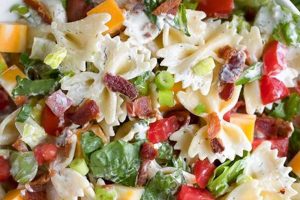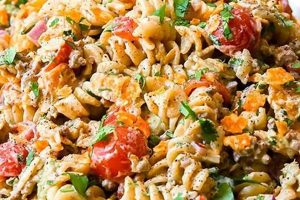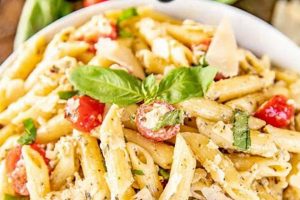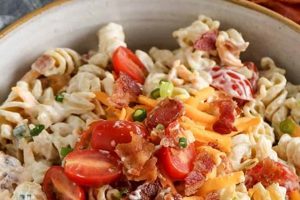Excellent cold pasta dishes typically combine cooked pasta, vegetables, a protein source (such as cheese, meat, or legumes), and a flavorful dressing. A classic example might include rotini pasta, chopped bell peppers, cucumbers, black olives, feta cheese, and a vinaigrette dressing. Variations are limitless, offering flexibility in ingredients and flavors to cater to diverse palates and dietary needs.
These dishes offer several advantages. They are generally easy to prepare, often utilizing readily available ingredients. Their versatility makes them suitable for a wide range of occasions, from potlucks and picnics to light lunches and side dishes. Furthermore, they can be highly nutritious, offering a balance of carbohydrates, protein, vitamins, and healthy fats, especially when incorporating whole wheat pasta and a variety of fresh vegetables. Historically, pasta salads gained popularity as a convenient and refreshing option, particularly during warmer months.
This exploration will delve further into specific ingredient combinations, dressing options, and techniques for crafting exceptional cold pasta dishes. Discussions on dietary adaptations, presentation tips, and storage recommendations will also be provided.
Tips for Exceptional Pasta Salads
Crafting a truly delicious cold pasta dish requires attention to several key elements. The following tips offer guidance for achieving optimal flavor, texture, and overall appeal.
Tip 1: Cook Pasta Al Dente: Pasta should be cooked until firm to the bite, as it will continue to soften slightly as it absorbs the dressing. Overcooked pasta can result in a mushy texture.
Tip 2: Chill Pasta Rapidly: After draining, rinse the cooked pasta under cold water to stop the cooking process and chill it quickly. This helps maintain its texture and prevents sticking.
Tip 3: Use High-Quality Ingredients: The freshest vegetables and flavorful cheeses and proteins enhance the overall taste and nutritional value. Consider seasonal produce for optimal flavor.
Tip 4: Balance Flavors and Textures: Aim for a variety of flavors and textures. Combine crunchy vegetables with creamy cheeses, tangy dressings with savory proteins, and soft pasta with crisp additions.
Tip 5: Dress Just Before Serving: Adding the dressing too early can make the salad soggy. Dress the pasta shortly before serving to maintain its optimal texture.
Tip 6: Taste and Adjust: After combining the ingredients, taste the salad and adjust the seasonings as needed. This ensures a balanced and flavorful final product.
Tip 7: Proper Storage: Store leftover pasta salad in an airtight container in the refrigerator for up to three days. Note that some ingredients, like mayonnaise-based dressings, may shorten the shelf life.
By following these tips, one can elevate a simple pasta salad into a culinary delight. Attention to detail, from ingredient selection to dressing technique, ensures a satisfying and flavorful dish.
These guidelines provide a strong foundation for creating delicious pasta salads. The following sections will explore specific recipe variations and further elaborate on maximizing flavor and presentation.
1. High-Quality Ingredients
The foundation of exceptional pasta salads lies in the selection of high-quality ingredients. Ingredient quality directly impacts the final dish’s flavor, texture, and overall appeal. Substandard ingredients can result in a mediocre, if not unpleasant, culinary experience, while premium components elevate the dish to a new level.
- Fresh Produce:
Using fresh, seasonal vegetables is crucial. Peak-season produce offers superior flavor and texture compared to out-of-season alternatives. Examples include ripe tomatoes, crisp cucumbers, and vibrant bell peppers. The freshness of these vegetables contributes significantly to the overall vibrancy and taste of the pasta salad.
- Premium Pasta:
Opting for high-quality pasta, such as bronze-die or artisanal varieties, enhances both the texture and flavor. These pastas hold their shape better and offer a more nuanced taste than generic options. The pasta serves as the base of the dish; its quality is paramount.
- Flavorful Cheeses and Proteins:
Incorporating flavorful cheeses, such as imported feta or fresh mozzarella, and high-quality proteins, like grilled chicken breast or succulent shrimp, adds depth and complexity. These ingredients contribute significantly to the overall satisfaction and nutritional value. Consider artisanal cheeses and responsibly sourced proteins for optimal results.
- Superior Dressings and Oils:
Utilizing extra virgin olive oil, high-quality vinegars, and freshly squeezed citrus juices for dressings makes a notable difference. These components provide a cleaner, brighter flavor profile compared to processed alternatives. The dressing ties the salad together; its quality significantly influences the final taste.
The synergy between these high-quality components results in a pasta salad that is not only visually appealing but also delivers a superior culinary experience. By prioritizing quality in each element, from the pasta to the dressing, one ensures a final product that exemplifies excellence in taste, texture, and overall satisfaction. A commitment to quality ingredients is the cornerstone of truly great pasta salad recipes.
2. Perfect Pasta Texture
Achieving the perfect pasta texture is paramount in crafting exceptional pasta salads. The texture significantly influences the overall enjoyment of the dish, impacting how the pasta interacts with the other ingredients and absorbs the dressing. A well-executed pasta texture contributes to a harmonious blend of flavors and a pleasant mouthfeel, while improperly cooked pasta can detract from even the most carefully chosen ingredients and dressings.
- Al Dente Consistency:
Cooking pasta “al dente,” meaning “to the tooth” in Italian, is crucial. This implies a slight resistance when bitten, indicating the pasta is cooked through but still firm. Overcooked pasta becomes mushy and absorbs too much dressing, leading to a soggy salad. Undercooked pasta, conversely, presents a hard, unpleasant texture. The al dente consistency allows the pasta to hold its shape, maintain a pleasant chewiness, and absorb the dressing without becoming overly saturated.
- Rapid Cooling:
Immediately rinsing cooked pasta under cold water halts the cooking process and helps achieve the desired texture. This rapid cooling prevents the pasta from continuing to cook in its residual heat, which can lead to overcooked, mushy results. The cold water also removes excess starch, preventing the pasta from sticking together and ensuring individual pieces remain distinct within the salad.
- Variety Selection:
Different pasta shapes hold their form and interact with dressings differently. Small shapes like rotini, farfalle, and shells work well for capturing dressing and smaller ingredients. Larger shapes like penne and fusilli provide a more substantial bite. The choice of pasta shape should complement the other ingredients and the overall desired texture of the salad.
- Oil Coating (Optional):
Lightly coating the cooled pasta with a small amount of olive oil can further enhance its texture and prevent sticking. This step creates a thin barrier that keeps the pasta pieces separate and adds a subtle richness. While optional, this technique contributes to a more pleasant mouthfeel and prevents the pasta from clumping together, especially if the salad is prepared in advance.
The interplay of these factorsachieving al dente consistency, employing rapid cooling techniques, selecting appropriate pasta varieties, and considering an oil coatingcontributes significantly to the final quality of the pasta salad. Attention to these details elevates the dish beyond a simple combination of ingredients to a carefully constructed culinary experience where texture plays a crucial role in enhancing overall enjoyment.
3. Flavorful Dressings
Flavorful dressings are essential for elevating pasta salads from simple to exceptional. The dressing acts as a unifying element, binding the ingredients together and imparting a cohesive flavor profile. A well-crafted dressing complements the other components, enhancing their individual characteristics while creating a harmonious blend of tastes and textures. The choice of dressing significantly influences the overall culinary experience, determining whether the pasta salad is refreshing, vibrant, rich, or tangy.
- Vinaigrettes:
Vinaigrettes, typically made with a combination of oil and vinegar, offer a light and tangy base for pasta salads. The ratio of oil to vinegar can be adjusted to achieve the desired level of acidity. Popular variations include balsamic vinaigrette, red wine vinaigrette, and lemon-herb vinaigrette. Vinaigrettes are particularly well-suited for pasta salads featuring fresh vegetables and lighter proteins, offering a refreshing counterpoint to richer ingredients.
- Creamy Dressings:
Creamy dressings, often mayonnaise or yogurt-based, provide a richer and more decadent flavor profile. These dressings can incorporate various ingredients, such as herbs, spices, and cheeses, to create unique flavor combinations. Classic examples include ranch dressing, Caesar dressing, and blue cheese dressing. Creamy dressings pair well with heartier pasta salads featuring ingredients like roasted vegetables, bacon, or grilled chicken.
- Pesto-Based Dressings:
Pesto, a vibrant sauce traditionally made with basil, pine nuts, garlic, Parmesan cheese, and olive oil, can serve as a flavorful and aromatic dressing. Its herbaceous and nutty notes complement a variety of pasta salad ingredients, especially fresh vegetables and cheeses. Variations using different herbs or nuts, such as sun-dried tomato pesto or walnut pesto, offer further flavor exploration.
- Global Influences:
Drawing inspiration from global cuisines can introduce unique and exciting flavors to pasta salad dressings. Asian-inspired dressings might incorporate sesame oil, soy sauce, ginger, and rice vinegar. Mexican-inspired dressings could utilize lime juice, cilantro, chili powder, and cumin. These diverse flavor profiles expand the possibilities for creating innovative and culturally rich pasta salad experiences.
The careful selection and preparation of the dressing are pivotal in achieving a well-balanced and flavorful pasta salad. The dressing should complement, not overpower, the other ingredients, allowing their individual characteristics to shine while contributing to a cohesive and satisfying whole. By understanding the various types of dressings and their potential flavor combinations, one can create pasta salads that are not only delicious but also reflect individual creativity and culinary preferences.
4. Vibrant Vegetables
Vibrant vegetables are fundamental to achieving greatness in pasta salads. They contribute not only crucial nutrients and textural variety but also vibrant colors and fresh flavors that elevate the dish beyond the ordinary. The strategic selection and preparation of vegetables significantly impact the overall aesthetic appeal, nutritional value, and culinary experience of the pasta salad. Exploring the multifaceted role of vegetables provides valuable insights into crafting truly exceptional dishes.
- Color and Visual Appeal
Vibrant vegetables introduce a spectrum of colors, transforming a pasta salad from a simple dish into a visually stunning culinary creation. Deep red tomatoes, bright orange carrots, verdant green spinach, and rich purple cabbage not only enhance the aesthetic appeal but also stimulate appetite. A visually appealing pasta salad is more inviting and contributes to a more enjoyable dining experience. This visual element is particularly important for buffet-style servings or potlucks where presentation plays a key role.
- Nutritional Enhancement
Incorporating a variety of colorful vegetables significantly boosts the nutritional profile of a pasta salad. Different colored vegetables contain different vitamins, minerals, and antioxidants, contributing to a well-rounded and healthful dish. For instance, red bell peppers are rich in vitamin C, while dark leafy greens like spinach provide vitamin K and folate. These nutritional benefits contribute to a more wholesome and satisfying meal, transforming the pasta salad from a simple side dish into a nutritious component of a balanced diet.
- Textural Contrast
Vegetables introduce a crucial element of textural contrast to pasta salads. Crisp cucumbers, crunchy bell peppers, and tender broccoli florets offer a variety of textures that complement the softness of cooked pasta. This interplay of textures creates a more dynamic and enjoyable eating experience, preventing the salad from becoming monotonous. The careful selection of vegetables with varying textures adds depth and complexity to the overall sensory experience.
- Flavor Dynamics
The inclusion of various vegetables introduces a complex interplay of flavors that enhance the overall taste profile of the pasta salad. Sweet corn, tangy red onion, peppery arugula, and earthy mushrooms each contribute unique flavor notes, creating a multi-dimensional culinary experience. These diverse flavors complement the other ingredients, such as the pasta and dressing, resulting in a well-balanced and flavorful dish that tantalizes the taste buds.
The considered incorporation of vibrant vegetables is integral to creating exceptional pasta salads. By focusing on visual appeal, nutritional value, textural contrast, and flavor dynamics, one can elevate a simple pasta salad into a culinary masterpiece that is not only delicious but also visually appealing and nutritionally balanced. These elements working in harmony transform a basic dish into a memorable and satisfying culinary experience.
5. Complementary Proteins
Complementary proteins play a crucial role in elevating pasta salads from side dishes to satisfying main courses. Their inclusion adds nutritional value, enhances flavor profiles, and contributes to a more texturally complex and enjoyable culinary experience. Understanding the impact of complementary proteins allows for the creation of well-rounded and flavorful pasta salads suitable for a variety of dietary needs and preferences.
Adding protein transforms a pasta salad into a more substantial and complete meal. Plant-based proteins like chickpeas, lentils, and edamame offer a vegetarian-friendly option while contributing fiber and other essential nutrients. Animal-based proteins, such as grilled chicken, shrimp, or cubed ham, provide a different flavor profile and textural element. Cheese, such as feta, mozzarella, or provolone, not only contributes protein but also enhances the creaminess and flavor complexity of the salad. The choice of protein should complement the other ingredients and the overall flavor profile of the dressing. For instance, grilled chicken pairs well with a lemon-herb vinaigrette, while chickpeas complement a tahini-based dressing. The combination of pasta, vegetables, and complementary protein creates a balanced and nutritious meal that satisfies hunger and provides sustained energy.
Strategic protein selection elevates the culinary experience of pasta salads. Cubed tofu, marinated and pan-fried, adds a savory element and pleasing texture. Flaked salmon introduces omega-3 fatty acids and a delicate flavor. Hard-boiled eggs contribute a creamy texture and subtle richness. These examples demonstrate the versatility and potential of incorporating complementary proteins to enhance both the nutritional value and the gastronomic appeal of pasta salads. Understanding the interplay of flavors and textures allows for the creation of well-balanced and satisfying dishes suitable for diverse palates and dietary requirements. By incorporating complementary proteins, pasta salads transition from simple side dishes to main courses offering a complete and satisfying culinary experience.
6. Creative Additions
Creative additions distinguish exceptional pasta salads from the commonplace. These additions, while not essential, introduce unexpected flavors, textures, and visual interest, elevating the dish beyond a simple combination of ingredients. They contribute complexity and depth, transforming a standard pasta salad into a memorable culinary experience. The impact of these additions extends beyond mere novelty; they offer opportunities to personalize recipes, cater to specific dietary needs, and explore a wider range of culinary possibilities.
Consider the addition of toasted nuts or seeds. Toasted pine nuts contribute a delicate crunch and buttery flavor to a Mediterranean-inspired pasta salad, while sunflower seeds offer a nutty taste and textural contrast in a Southwestern-style variation. Dried fruits, such as cranberries or chopped apricots, introduce a touch of sweetness and chewiness. Fresh herbs, like chopped basil, parsley, or mint, provide a burst of freshness and aroma. These additions, while seemingly small, significantly impact the overall sensory experience, adding layers of flavor and texture that elevate the dish. Crumbled bacon adds a smoky, savory dimension, while toasted breadcrumbs provide a satisfying crunch. These examples illustrate how creative additions can personalize a pasta salad, catering to individual preferences and dietary restrictions, such as adding roasted chickpeas for extra protein or using gluten-free pasta for those with sensitivities. The possibilities are vast, allowing for culinary exploration and innovation.
Strategic incorporation of creative additions requires careful consideration of flavor profiles and textural balance. The additions should complement, not overpower, the other ingredients, contributing to a harmonious blend of tastes and textures. Overuse of creative additions can lead to a muddled flavor profile and an overwhelming sensory experience. The goal is to enhance, not detract from, the overall quality of the pasta salad. By understanding the impact of creative additions, one can transform a basic pasta salad into a culinary creation that is both delicious and memorable, reflecting individual creativity and culinary expertise. These seemingly minor additions unlock the potential for truly exceptional pasta salads, demonstrating the power of thoughtful ingredient selection and culinary innovation.
7. Proper Storage
Proper storage is crucial for preserving the quality and safety of pasta salads, ensuring they remain a “great” culinary option. Improper storage can lead to bacterial growth, spoilage, and undesirable changes in texture and flavor, negating the efforts put into creating a delicious and visually appealing dish. Understanding and implementing correct storage techniques is essential for maximizing the shelf life and maintaining the intended quality of pasta salads.
- Container Selection
Choosing the right container is the first step in proper storage. Airtight containers are essential for preventing the salad from drying out and minimizing exposure to airborne contaminants. The container should be appropriately sized to hold the salad comfortably without excessive air space. Using multiple smaller containers for individual portions can be more practical than storing a large batch in a single container, especially if the salad will be consumed over several days. This minimizes the repeated exposure of the entire batch to air and potential contamination.
- Temperature Control
Maintaining a consistent and appropriate temperature is paramount. Pasta salad should be refrigerated promptly after preparation and kept at a temperature of 40F (4C) or below. This temperature range inhibits the growth of most harmful bacteria. Avoid leaving pasta salad at room temperature for extended periods, especially in warm environments, as this can promote rapid bacterial growth and increase the risk of foodborne illness. Monitoring refrigerator temperature and ensuring proper air circulation are essential for safe storage.
- Ingredient Considerations
Certain ingredients, such as mayonnaise-based dressings, are more susceptible to spoilage than others. Pasta salads containing these ingredients should be consumed within a shorter timeframe, typically within two to three days. Ingredients like fresh vegetables, particularly leafy greens, can wilt or become soggy over time, impacting both texture and flavor. Understanding the shelf life of individual ingredients helps determine the overall storage duration of the pasta salad. Prioritizing ingredient quality and freshness contributes to longer shelf life and minimizes the risk of spoilage.
- Storage Duration
Even with proper storage techniques, pasta salad has a limited shelf life. Generally, pasta salad is best consumed within three to five days of preparation. Beyond this timeframe, the quality deteriorates, and the risk of spoilage increases significantly. Visual inspection and smell tests can help determine if the salad is still safe to consume. Any signs of mold, off-odors, or unusual texture indicate spoilage, and the salad should be discarded immediately. Adhering to recommended storage durations is crucial for ensuring food safety and preventing foodborne illnesses.
By adhering to these proper storage practices, the longevity and quality of great pasta salad recipes are significantly enhanced. These techniques ensure that the time and effort invested in preparing a delicious and visually appealing dish are not compromised by spoilage or undesirable changes in flavor and texture. Proper storage is an integral part of the overall process, preserving the intended culinary experience and maximizing the enjoyment of great pasta salads.
Frequently Asked Questions
This section addresses common inquiries regarding the preparation and enjoyment of high-quality pasta salads.
Question 1: How long can pasta salad be safely stored?
Properly stored pasta salad, kept in an airtight container at 40F (4C) or below, typically remains safe for consumption for three to five days. Salads with mayonnaise-based dressings or highly perishable ingredients should be consumed within two to three days. Always assess the salad’s quality before consumption, looking for any signs of spoilage like mold, off-odors, or unusual texture.
Question 2: What type of pasta is best suited for pasta salad?
Shorter pasta shapes, such as rotini, farfalle, fusilli, and penne, generally work well in pasta salads. These shapes hold their form, capture dressing effectively, and mix easily with other ingredients. Larger shapes can also be used but may require breaking into smaller pieces for optimal integration.
Question 3: Can whole wheat pasta be used?
Whole wheat pasta offers a nutritional advantage, providing more fiber and nutrients. It can be successfully incorporated into pasta salads, but requires careful attention to cooking time to avoid a mushy texture. Cooking al dente is crucial.
Question 4: How can one prevent pasta salad from becoming soggy?
Sogginess can be avoided by cooking pasta al dente, rinsing it under cold water after cooking, and adding the dressing just before serving. If preparing the salad in advance, lightly coating the pasta with olive oil can also help prevent sticking and absorption of excess dressing.
Question 5: What are some suitable vegetarian protein options for pasta salad?
Excellent vegetarian protein sources include chickpeas, lentils, black beans, edamame, and cubed tofu. These options add nutritional value and textural variety to the salad.
Question 6: How can one customize a pasta salad recipe?
Pasta salad recipes are highly adaptable. Customization can include varying vegetables, proteins, cheeses, and dressings. Creative additions like herbs, nuts, seeds, and dried fruits further expand possibilities, catering to individual preferences and dietary needs.
Careful attention to ingredient selection, preparation techniques, and storage practices ensures the creation of truly exceptional pasta salads. These guidelines provide a foundation for crafting delicious, nutritious, and visually appealing dishes suitable for a variety of occasions.
The next section will explore specific recipe variations, offering inspiration and guidance for crafting your own signature pasta salad creations.
Great Pasta Salad Recipes
Exceptional pasta salads are achievable through deliberate attention to detail. From the selection of premium ingredientsfresh, seasonal vegetables, high-quality pasta, and flavorful proteinsto the nuanced art of crafting complementary dressings, each component contributes to the overall culinary experience. Achieving the perfect pasta texture, “al dente” yet tender, and incorporating creative additions that enhance flavor and visual appeal are crucial elements in achieving excellence. Proper storage techniques further ensure that the carefully crafted salad maintains its quality and remains a safe and enjoyable culinary creation.
Culinary exploration within the realm of pasta salads offers boundless opportunities for creativity and innovation. By understanding the interplay of flavors, textures, and visual elements, individuals can elevate simple combinations of ingredients into truly exceptional dishes. The ongoing pursuit of crafting great pasta salad recipes promises continued culinary satisfaction and the potential for discovering new and exciting flavor combinations.






